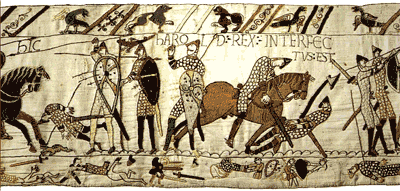1066 A year of deceit, despair and death
This is a history project work written by the elder granddaughter of Mr. David Wright, Emily Wright, 12.
The trouble started on the 5th of January 1066 when King Edward1 died at the age of 61, childless and leaving no sure evidence of whom the next heir2 was to be. This caused all the trouble.
There were three main candidates for King:
- Harold Godwinson, (Harold) who was the brother-in-law to King Edward. He was also the Earl of Wessex and was apparently told the throne was his.
- Duke William of Normandy, who apparently King Edward the Confessor promised the throne to. In the past, Normandy had looked after and helped King Edward’s family.
- Harold Hardrada of Norway, (Hardrada) wasn’t a big threat to William or Harold because, although ambitious, determined and vicious3, he didn’t have a very large army as many Norwegians were on Harold’s side.

Emily Wright
But the choice was up to the Witan (the English council). They weren’t very keen4 on Hardrada because he was Norwegian. Harold told William he would let William be king but tricked5 William and soon after Edward’s death, Harold was crowned.
Hardrada and, especially, William were angry. William decided it was time to INVADE!
Harold waited for William to invade but William couldn’t invade because of a poor wind6. But Hardrada did invade and the Battle of Stamford Bridge began and ended with Hardrada being hung on a tree and cut into four. In that battle many Norwegians died. They came in 30 boats and left in only 3! Many of King Harold’s soldiers died as well. Soon Harold received word that William had landed in Sussex. Poor old Harold, having just fought an extremely tiring battle, marched all the way over to Sussex. He had lost so many men in the battle that he had to collect peasants on his way to Sussex. The two armies met outside Hastings. Harold had the advantage because he was at the top of the hill and William was at the bottom of the hill by the castle. But William outsmarted7 Harold.
“Retreat!” shouted William and retreated.
Harold followed.
 Suddenly William turned round and shouted “Attack.” Harold was so surprised. In the middle of the battle Harold died.
Suddenly William turned round and shouted “Attack.” Harold was so surprised. In the middle of the battle Harold died.
The Bayeux tapestry8 shows a man who has an arrow through his eye, but we are not certain it is Harold.
This wasn’t the end of the story for William. He had many more problems:
- How will I control a country like England?
- Who else will I have to fight?
- How harsh9 will I have to be to earn the respect of the English and get them to obey me?
The answer to question 3 is ‘very harsh’!
 After winning the Battle of Hastings he captured all the castles along the southeast coast of Britain. On his way to London he killed many innocent people and burnt down whole villages. The Witan then surrendered and told William he could be King. On the 25th of December 1066, William was crowned King.
After winning the Battle of Hastings he captured all the castles along the southeast coast of Britain. On his way to London he killed many innocent people and burnt down whole villages. The Witan then surrendered and told William he could be King. On the 25th of December 1066, William was crowned King.
The main reasons Harold lost, I think, are
- Harold lost many of his best soldiers in the Battle of Stamford Bridge and had peasants fighting instead and they didn’t have very good weapons.
- Harold and his men were tired after walking so far.
- William’s crafty trick made Harold lose his strong position on the hill.
- William’s men were fresh.
The main source of information about the Battle of Hastings is the Bayeux tapestry. It was made probably in England after the conquest. It was paid for by William’s half brother. The embroidered10 linen strip is 69 metres long, and tells the story from Harold’s visit to William in 1064 to his defeat at Hastings. It was done by women, who weren’t actually there, so they had to make some parts up. It was also biased in favour of William.
1 King Edward (the Confessor) – король Эдуард Исповедник
2 heir – наследник
3 vicious – (зд.) злой
4 keen (on) – стремящийся
5 trick – обманывать
6 poor wind – безветрие
7 outsmart – (разг.) перехитрить
8 Bayeux tapestry – средневековый гобелен из французского города Байо
9 harsh – суровый
10 embroider – вышивать
Читать еще в этой рубрике:
Читать еще в этом номере:
|











